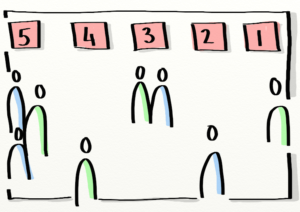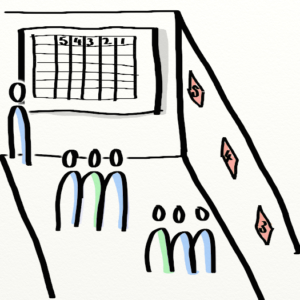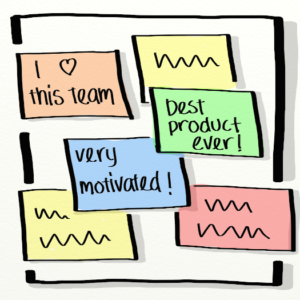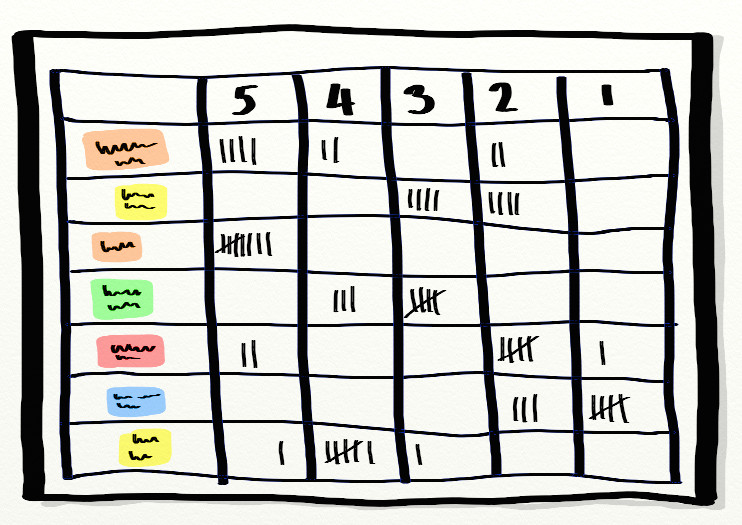 This is a strong retrospective for bringing issues up to the surface. Instead of just one person expressing an issue as a positive or a negative, the whole team feedbacks about the importance of the issue. The team then decides which issues to tackle. The retrospective also exposes issues where there is not common view, and highlights areas of alignment. It also allows the team to ask tough questions in a safe environment.
This is a strong retrospective for bringing issues up to the surface. Instead of just one person expressing an issue as a positive or a negative, the whole team feedbacks about the importance of the issue. The team then decides which issues to tackle. The retrospective also exposes issues where there is not common view, and highlights areas of alignment. It also allows the team to ask tough questions in a safe environment.
Material
Post it notes, pens and a white board. A room that has space for the participants to move around.
Preparation
On 5 post it notes write down the numbers 1 – 5. Space them out on a wall radiating out from the board, with 5 closest to the board, and 1 furthest away. On the whiteboard, set up a grid with 6 columns, the first column is for the post it notes, number the next 5 columns from five to one.
Method
Check in with the team
What happened this sprint, and how do they feel about it?
Generate insightful statements
Ask each person to write down statements, one per post-it note. These need to be strongly opinionated, the more precise the better. Make sure to give your team some examples especially if this is their first time running this retrospective. E.g:
 The product we’re working on is going to be the best in class.
The product we’re working on is going to be the best in class.- We will be able to finish features 1, 2 and 3 before the holidays.
- I feel motivated to work on this team.
- I love coming into work every morning.
A couple of notes per person is good. Some people have a hard time coming up with statements, others can think up of tons, and that’s ok.
Statements that are more specific will generate better insights and discussions. But this typically self corrects, someone typically asks for clarification when a statement is unclear.
Visualize the team’s opinions
Gather the post it notes from the participants. Read out the notes one at a time. Instruct the team to vote with their feet, by standing closest to the number that best represents how much they agree with the statements. A 5 is “strongly agree”, a 1 is “strongly disagree”, and a 3 is “neutral”. To keep it easy stick with whole numbers, this is just to give the team a general idea of what everybody else thinks.
Place the post it note in the first column. Record the votes on the board after reading each statement.
Continue until all the statements have been read. Ask the author of the statement to clarify if a question comes up.
Vote for topics to discuss
Ask the team to vote on which statements they’d like to discuss. Dot voting on the board works well, or choose your favorite method.
Discuss and agree to actions
Start with the statement that has the most votes, and see how far you get, typically 2-3 statements will get the most votes. Sometimes it’s enough for the team to discuss the statement, and reach a common understanding. Most often there will be action points. If there are too many action points on the board, ask the team which ones will give them the most bang for the buck and agree to those.
Positive feedback
End the retrospective by asking the team for spontaneous appreciations. This opens up for people to thank those who were especially vulnerable in discussions during the retrospective, and also for giving positive feedback to individuals or to the whole team that weren’t captured given this retrospective format.
Feedback about the retro
It’s good to end the retrospective by asking for feedback. You can do this in any way you like, by asking for a return on time investment, by doing a meta retrospective of the retrospective, by asking for improvements. Whatever method you choose, make sure you get the feedback you need so you’re facilitating meetings that are valuable and helpful to the team.




Nice format! I used it for a large retrospective with 20+ participants. It really helped getting everybody up and moving, nobody was bored and we had some great insights and results.
Nice to hear!